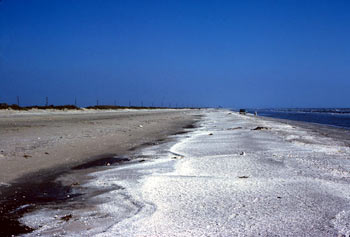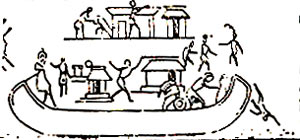|
Captain
Dynamite
John
wandered aimlessly around the dock of Iron Babel, looking for
some risky adventure that would release him from the routine
of his life. This opportunity presented itself in the first
days of summer 1888, when an affluent Cuban arrived in the
city in need of a brave captain to transport sixty tonnes of
dynamite to Panama.
The rumour
in the taverns was that the dynamite would be used for a
planned insurrection in Cuba. The Cuban already had a
schooner, The Rambler, which he had purchased
from Commodore Thomas, and which was the largest ship in the
New York shipyard. Yet the days passed without him finding the
daring captain who would take this dangerous cargo to the port
of Colón. As soon as they found out what it was they would be
transporting in the hold they refused.
‘Don’t
waste your time, my friend, go see the Irishman O’Brien. He’s
the man you’re looking for’, he was told when he was already
contemplating returning to the Isthmus empty-handed.
|

Gulf of Mexico at the
border of Texas and Louisiana
(Morton Robert A. Coastal Classification Atlas)
|
On first
impressions, he thought that they had been joking with him.
The Irishman did not look like much. He was short and thin. He
thought that this man could never be the protagonist of the
extraordinary feats he had been told about. Nevertheless, he
had no other candidate.
O’Brien
accepted immediately, attracted more by the adventure than by
the large sum he was offered. The dynamite was packed in
cylindrical containers one inch in diameter and a foot long,
protected by sawdust and placed in fifty-pound boxes.
While the
schooner waited under the watchful eye of the Statue of
Liberty, O’Brien lied in order to hire a crew. He told the
sailors that they were going to Panama to collect the ship’s
owner, who owned a coal business. He also told them that from
there they would embark on a long voyage and that was why they
were carrying plentiful provisions in the hold.
These were
the first days of summer. In the Gulf of Mexico the waves
gently beat against the schooner. The sky was clear. The
evening fell early and the sailors who were not on watch soon
gave in to slumber only to be awoken in the midst of thunder,
lightning and heavy rain.
The gusts
of wind threatened to carry off the sails with them. O’Brien
ordered them to be lowered immediately. The Rambler
galloped about like a rider on a wild horse. Some sailors
prayed, while the captain only thought about the risk of an
electrical charge falling on the boxes of dynamite - and boom.
At
midnight the storm still had not diminished in intensity. The
brusque movements of the boat could have caused an explosion.
O’Brien slipped down to the hold to make sure that the boxes
were in their places. His fears were not unfounded. Using some
pieces of wood and canvas straps he managed to return them to
order. The boat continued creaking as if, at a second’s
notice, it would shatter into pieces. It was a long night.
Finally
the sun laid the last traces of the storm to rest. At full
speed, the schooner sailed to Jamaica, where they took on ice.
Then they continued on to Boca del Toro. There they handed
over the vessel and each man went his separate way.
O’Brien
waited for the boat that would take him to New York. Every day
he walked along the narrow streets of the old port where there
was little to admire. To make matters worse, cholera invaded
the captain’s body. As soon as he could get out of bed he left
for the United States. There his colleagues in Hell Gate, in
between jokes and deep gulps of whiskey, baptised him John
Dynamite. That is how he became known during the war of 1895,
during which he served Cuba’s cause for independence against
the Spanish. In this struggle he left a trail of heroic
exploits in his wake, carving legends of bravery.
On his
steamship Bermudas and on other vessels he transported
valuable war supplies and rebel troops to the island. Among
the illustrious passengers he carried was Calixto García,
Lieutenant-General of the Liberation Army of Cuba. His
adventures at sea, thwarting Spanish cannons, and throwing
Spanish and Yankee spies off the scent in the United States,
could be the plot of a novel. But that is another story and
one that will be told in the next issue of this publication.
José Antonio
Quintana García
References
-
Castellanos García, Gerardo. Tierras y Glorias de Oriente
(Havana: Editorial Hermes, 1927).
- García
del Pino, César. Expediciones de la Guerra de Independencia.
1895-1898 (Havana: Editorial de Ciencias Sociales, 1996).
- González
Barrios, René. En el mayor silencio (Havana: Editora
Política, 1990).
-
Pertierra Serra, Enrique. Italianos por la libertad de
Cuba
(Havana: Editorial José Martí, 2000).
- Portell
Vilá, Herminio. Vidas de la unidad
americana,
25 biografías de americanos ilustres
(Havana: Editorial Minerva, 1944).
- García,
Ángel and Piotr Mironchuk. Diario de un mambí ruso (Havana:
Editorial de Ciencias Sociales, 1984).
Archival
Sources
John
O’Brien. Memoirs (manuscript in Sala Cubana, José Martí
National Library, Cuba).
Notes
[1] José
Antonio Quintana García (Ciego de Ávila, 1970), B.A. Education
1996. A Cuban professor of history, editor and journalist,
Quintana García is editor-in-chief at the weekly Invasor.
He is the author of Alas de Cóndor (2001), Crónica
de una matanza impune (2001), Más allá
del
soldado, anécdotas del Che
(2004) and other books and articles.
[2] A copy of John’s memoirs is housed in the Sala Cubana of
Cuba’s José Martí National Library. The translator’s name does
not appear.
[3] Herminio Portell Vilá, ‘John O’Brien Dinamita, el Capitán
Dinamita’ in Vidas de la unidad americana, 25 biografías de
americanos ilustres, Editorial Minerva, Havana (1944),
358. |


